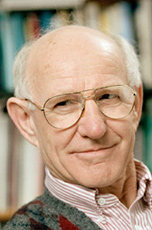Emergence and Control of Pandemic Influenza

Robert G. Webster, PhD
National Academy of Sciences Member, 1998
Fellow of the Royal Society, London, 1989
Thursday, November 13th
2:00 p.m. - 3:00 p.m.
Frick Auditorium, Mosier Hall
College of Veterinary Medicine
Biographical Sketch:
Dr. Webster is a member of the Infectious Diseases Department at St. Jude Children's Hospital. He received his PhD degree from the Australian National University, Canberra. Dr. Webster's interests include the structure and function of influenza virus proteins and the development of new vaccines and antivirals; the importance of influenza viruses in wild birds as a major reservoir of influenza viruses and their role in the evolution of new pandemic strains for humans and lower animals. His curriculum vitae contains over 400 original articles and reviews on influenza viruses. He has mentored many individuals who have been successful in contributing to our knowledge of influenza as an emerging pathogen.
Abstract:
Pandemic influenza is a zoonotic disease caused by the transfer of influenza A viruses or virus gene segments from aquatic bird reservoirs to humans and domestic animals. In wild aquatic birds-the natural hosts of influenza viruses-these viruses exist in harmony with their hosts and are non-pathogenic. After transfer to other species influenza viruses evolve rapidly. In humans pandemics of influenza emerge at irregular intervals; in the last century three major pandemics occurred including the catastrophic 1918 Spanish H1N1 pandemic, the 1957 Asian H2N2 and the 1968 Hong Kong H3N2 pandemics and the reemergence of the H1N1 Russian influenza in 1977. In the interim seasonal influenza occurs that can cause high mortality in the young and the elderly with peaks of activity in the winter months in temperate and throughout the year in tropical countries.
Among the influenza A viruses there are 16 hemagglutinin and 9 neuraminidase subtypes. Of the hemagglutinin subtypes the H2, H5, H6, H7, and H9 viruses are considered to have future pandemic potential. In my presentation the potential of each of these will be discussed and the options of control strategies will be evaluated.
Full Profile of Dr. Webster (.pdf)
St. Jude Article
ABC News Story
USA Today News Story
UPMC Center for Biosecurity Presentation
This lecture is sponsored by the Department of Diagnostic Medicine and Pathobiology, University Distinguished Professors, and the Office of the Provost.
